Carbon fiber filaments have an incredible strength-to-weight ratio, good tensile strength, and resistance to corrosion and fatigue. They use tiny fibers cut to 0.01mm strands, blended with filaments like PETG and Nylon to make them tougher.
The best carbon fiber filament I’d recommend for most users is NylonX from Matterhackers. It offers the best performance for most uses with the Nylon base, and it’s extremely durable, with a low friction coefficient and impressive heat stability.
That said, XT CF20 Colorfabb is a cheaper option if you’re looking for a budget pick, or there are also low-cost carbon fiber PLA filaments like Protopasta carbon-fiber reinforced PLA for even cheaper and you can handle the brittleness.
We’ve included carbon fiber filaments mixed with PETG, Nylon, ABS, PLA, PC, and PP with our top recommendations.
The Best Carbon Fiber Filaments & Brands – 2024 Reviews
| Filament | Base Filament | Percent of CF | Price |
|---|---|---|---|
| Polymaker PolyLite™ PLA-CF | PLA | 8% | $35.00 |
| Protopasta Carbon Fiber Reinforced PLA Filament | PLA | 15% | $60.00 |
| 3DXTech CarbonX ABS+CF | ABS | not specified | $64.00 |
| 3DXTech CarbonX PETG+CF | PETG | not specified | $64.00 |
| ColorFabb XT CF20 | PETG | 20% | $74.00 |
| Prusament PC Blend Carbon Fiber | Polycarbonate (PC) | not specified | $75.00 |
| Braskem Polypropylene Carbon Fiber | Polypropylene (PP) | not specified | $86.00 |
| MatterHackers NylonX | Nylon | 20% | $116.00 |
| BASF PAHT CF | Nylon | 15% | $120.00 |
| Raise3D PA12 CF | Nylon | 10-30% | $190.00 |
1. MatterHackers NylonX (Carbon Fiber Nylon Filament)
- Price: $58 for 0.5kg ($116/kg) – Available at MatterHackers here
- Filament base:Nylon
- Percent of carbon fiber: approximately 20% by weight
- Extruder temperature: 250 – 265°C
- Heated bed temperature: 60-65°C for Garolite, 80°C for Glass with glue stick
- Density: 1.00g/cm³
- Diameter available: 1.75mm & 2.85mm

Nylon and carbon fiber filaments are some of the best carbon fiber blends, although PETG-based CF filaments are still significantly better than ABS or PLA-based composites. NylonX is MatterHackers’ take on this combination of Carbon Fiber Nylon Filament.
Nylon polymer is arguably the best material currently available to 3D print for the majority of performance applications.
Nylon is one of those materials that just has it all. Extreme durability, great chemical and heat stability, and a low friction coefficient. And with its great durability, it naturally makes for a perfect pairing with the otherwise fairly brittle CF.
Granted, Carbon fiber 3D printer filament has a rougher, matte finish, so the low friction advantage isn’t as good as non-composite Nylon, but it’s still a favorable factor over other base resin materials if this is a concern.
It’s worth noting though that all Nylon based filaments should always be dried before printing. Nylon filament is extremely hygroscopic and can absorb a lot of moisture in a short time frame. If you hear popping during printing, there’s too much moisture.
Again as with ColorFabb’s XT CF20 above, Nylon X diameter tolerances are a reasonable +/-0.05mm of the advertised size. This is a mid-range Nylon Carbon Fiber filament.
2. ColorFabb XT CF20 (Carbon Fibre PETG Filament)
- Price: $54.95 for 0.75kg (approx $74/kg) – Available at Matterhackers here
- Filament base:PETG
- Percent of carbon fiber: 20%
- Nozzle temperature: 240 – 260°C
- Heated bed temperature: 60 – 70°C
- Density: 1.35 g/cm³
- Diameter available: 1.75mm & 2.85mm
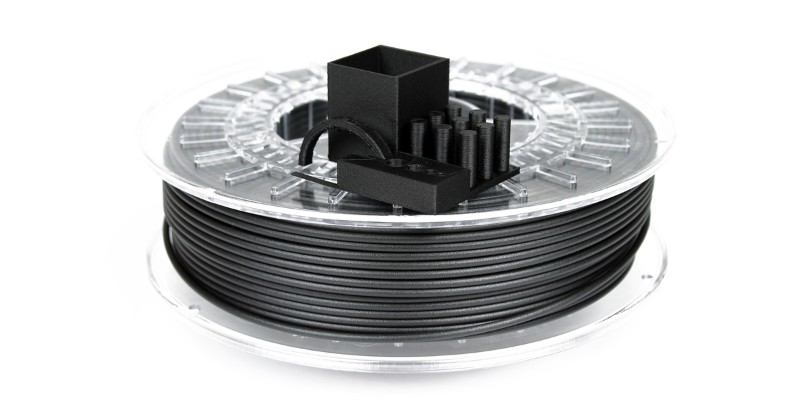
ColorFabb ‘XT’ is basically the same popular PETG (think PET in plastic bottles, but Glycol-modified for strength) but with a 20% fiber reinforcement.
As with all carbon fiber 3D filament, it’s important you use a hardened nozzle. A regular brass nozzle will wear out in a few short hours of printing.
It’s also worth bearing in mind most fiber or composite filaments are best printed with 0.5mm or larger nozzles. If the particles in the filament are not sufficiently nano-sized then blockages can occur easily on smaller nozzle sizes.
PETG filament is rather dense so naturally, XT has a higher-end density, at 1.27 g/cm³. Not so much an issue when printing most things, but if weight is a concern, you may be interested in lower-density materials (like Nylon) that are up to 20% lighter for the same volume.
ColorFabb is a known industry benchmark, promising tolerances of +/-0.05mm of their advertised 1.75mm or 2.85mm sizes. Generally, the tighter the tolerances, the cleaner your prints will look – so it’s worth watching out for. Tolerances that are too wide can even lead to blockages, so be wary of +/-0.10mm variances in cheaper filaments.
Other benefits of XT CF20, in line with PETG filaments, are low warp and good durability. It is worth taking into consideration the typical printing nuances of PETG for best results, which you can find more info on here.
3. Prusament PC Blend Carbon Fiber – Best Carbon Fiber Polycarbonate Filament
- Price: $59.99 (approx $60) for 0.8kg (approx $75/kg) – Available at Prusa here
- Filament base:Polycarbonate
- Percent of carbon fiber: not specified
- Extruder temperature: 285 ± 10°C
- Heated bed temperature: 110 ± 10°C
- Density: 1.22 g/cm³
- Diameter available:1.75mm
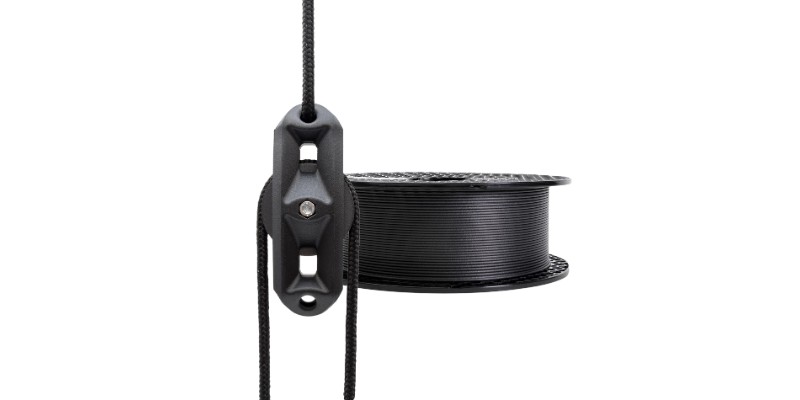
Prusament PC blends PC with carbon fiber for better temperature resistance, UV resistance, chemical resistance, and toughness than normal PC. PC is already a strong polymer used in many hard-wearing applications, and adding carbon fiber further improves this, increasing heat resistance up to 114°C.
However, PCCF struggles printing more complex, thinner geometries, which tend to snap under stress due to lower impact resistance than standard PC, so is best suited to larger parts.
PCCF suits mechanical parts, machine parts, and any type of component that requires excellent heat resistance. The CF ensures parts are sturdier, less prone to stresses and bending, and retain their dimensional stability.
PCCF is much easier to print than standard Polycarbonate. It warps less, and doesn’t even require an enclosure. Though, you must still use a hardened steel nozzle, as the abrasive qualities of the carbon fibers will tear through brass nozzles.
Lastly, PCCF offers a unique finish with a distinctive black matte surface and clean layers. Prusament achieves this through a guaranteed ±0.04 mm precision, up from the ±0.05 mm
4. BASF PAHT CF – Most Popular Carbon Fiber Nylon Filament
- Price: $89.99 for 0.75kg (approx $120/kg) – Available at Matterhackers here
- Filament base: Nylon
- Percent of carbon fiber: 15%
- Nozzle temperature: 260 – 280 °C
- Heated bed temperature: 100 – 120°C
- Density: 1.23 g/cm³
- Diameter available:1.75mm & 2.85mm

BASF PAHT CF mitigates the brittleness of carbon fiber while still conserving its dimensional stability by blending it with Nylon. The resulting filament is tough, stiff, impact resistant, and has a high tensile strength. The blend breaks down to 85% Nylon and 15% carbon fiber.
BASF PAHT CF is manufactured to be engineering-grade, and is one of the best carbon fiber filament blends for performance prototyping and batch production of parts for engineering and mechanical applications.
Warping is an issue when using BASF PAHT CF, but slower print speeds, a brim, and glue solve the problem. Similar to most carbon fiber filaments and their natural abrasive properties, avoid printing BASF PAHT CF with brass nozzles in favor of hardened nozzles. Water absorption is also a concern (like with all Nylon filaments), so dry the filament before use for the best results.
BASF guarantees ±0.05 mm tolerances for every spool, which is the industry standard, but not the best out there. For most projects this won’t matter, but if you are working to tight parameters, you may want to consider alternatives, especially those manufactured by Prusament.
5. Protopasta Carbon Fiber Reinforced PLA Filament – Best Carbon Fiber PLA
- Price: $29.99 for 0.5kg (approx $60/kg) – Available at Matterhackers here
- Filament base: PLA
- Percent of carbon fiber: 15% by weight
- Nozzle temperature: 260 – 205 °C
- Heated bed temperature: 100 – 60°C
- Density: Approx. 1.3g/cm³
- Diameter available:1.75mm & 2.85mm

Protopasta Carbon Fiber Reinforced PLA Filament combines standard PLA polymer with 15% carbon fiber. As counterintuitive as it may seem to make an already-brittle material even more brittle, the blend of PLA and CF is rigid with superb structural strength that shines in non-bending applications.
This PLA carbon fiber filament blend is more rigid than standard PLA, but less flexible. The filament buckles and distorts when bent.
Ideal uses for Protopasta Carbon Fiber Reinforced PLA Filament include structural supports, frames, and shells.
The carbon fiber leaves a distinctive, professional-looking matte finish and gives prints rigidity, while the high PLA content makes for easy, low warp printing with standout layer adhesion. I recommend a 0.6 mm hardened nozzle for the best results.
The filament has poor temperature resistance due to the high PLA content, so you’re best looking into alternatives like PCCF or Nylon CF for high-temp uses.
6. Polymaker Carbon Fiber PLA
- Price: Check latest price at Amazon here
- Filament base: PLA
- Percent of carbon fiber: 8% by weight
- Nozzle temperature: 190˚C – 220˚C
- Heated bed temperature: 30˚C – 70˚C
- Density: 1.29 g/cm³ at 23°C
- Diameter available: 1.75mm
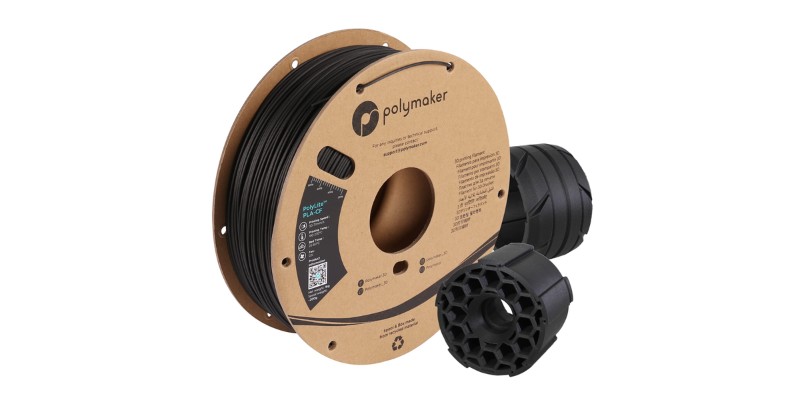
Polymaker Carbon Fiber PLA blends PLA with 8% carbon fiber to offer makers an extremely rigid material.
The main benefit is the easy printing properties of PLA (low warping, strong adhesion, and no need for an enclosure), with the structural toughness of carbon fiber. Better yet, Polymaker Carbon Fiber PLA costs similar prices to standard PLA, so it’s the most affordable carbon fiber filament on our list.
Polymaker Carbon Fiber PLA also stands out for the quality of the finish – a smooth, uniform matte black that conceals layer lines well to give parts an unmistakable professional look.
However, Polymaker Carbon Fiber PLA tends to require more print speed and retraction tuning than other PLA CF options like Protopasta. So, it may not be ideal if you want a PLA CF option that excels out of the box.
7. 3DXTech CarbonX PETG+CF – Great PETG Carbon Fiber Blend
- Price: $48.00 for 0.75kg (approx 64/kg) – Available at Matterhackers here
- Filament base: PETG
- Percent of carbon fiber: notspecified
- Extruder temperature: 230-260°C
- Heated bed temperature: 70-90°C
- Density: 1.34 g/cm³
- Diameteravailable:1.75mm & 2.85mm
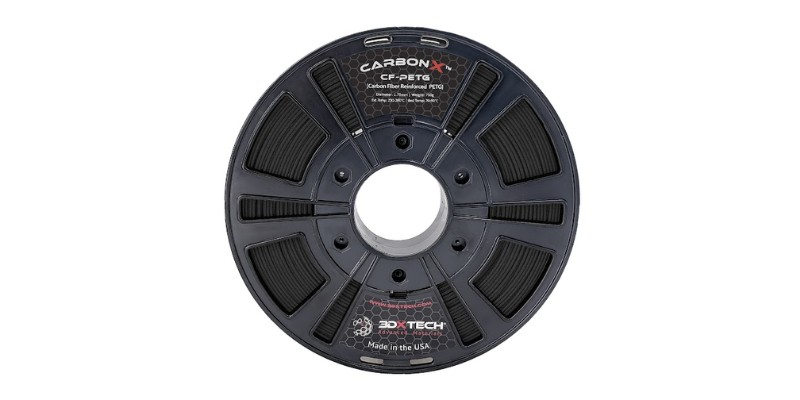
3DXTech CarbonX PETG+CF blends PETG with carbon fibers for strong, stiff, dimensionally stable, heat tolerant, and chemical resistant parts. In other words, the best of both worlds and a rugged material that can withstand stresses and pressure well.
The CF content is high-modulus carbon fiber as opposed to the powders and milled fibers typically found in carbo fiber blends, which makes it more structurally sound than rival options while still being lightweight. These are aligned to match the axis of the PETG for superb dimensions and to give the material a clean, satin finish.
The main benefit compared to Nylon carbon fiber filaments is a much easier printing experience with less warping, shrinking, and peeling, even on non-enclosed printers. It’s reliable, and offers a clean surface finish. You’ll need a hardened steel nozzle with a bore diameter of at least 0.4 mm, and you’ll want to avoid PEI beds and use glue/hair spray to help with adhesion.
3DXTech CarbonX PETG+CF shines when used for performance applications such as rigid and lightweight parts for civil engineering, aerospace, and motorsports applications.
8. 3DXTech CarbonX ABS+CF Filament – Best ABS Carbon Fiber Filament
- Price: $48.00 for 0.75kg (approx $64/kg) – Available at Matterhackers here
- Filament base: ABS
- Percent of carbon fiber: not specified
- Extruder temperature: 220-240°C
- Heated bed temperature: 100-110°C
- Density: 1.11 g/cc
- Diameteravailable: 1.75mm & 2.85mm
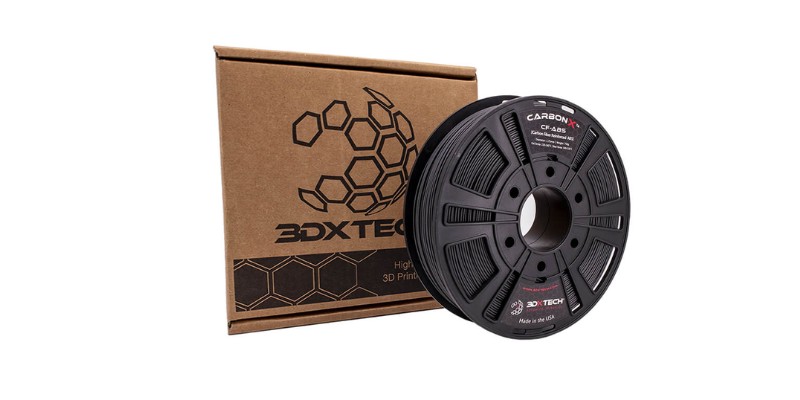
3DXTech CarbonX ABS+CF Filament offers a blend of 85% Sabic MG-94 ABS and 15% carbon fiber.
ABS delivers stronger and more durable prints than PLA, along with chemical resistance and low melting point, while carbon fiber improves dimensional stability, mechanical strength, keeps weight down, and gives it a distinctive matte black finish and smooth surface finish.
3DXTech CarbonX ABS+CF requires a hardened steel nozzle with a minimum bore diameter of 0.4 mm. Additionally, the ABS component of the blend means you’ll need an enclosure to reduce warping. You’ll also want to use an adhesive such as hairspray or glue to help with first-layer adhesion
These steps make 3DXTech CarbonX ABS+CF harder to work with than PLA or PETG blends, but 3D printed parts are substantially more durable and suitable for more demanding applications.
This ABS carbon fiber filament is ideal for applications where standard ABS often isn’t strong enough, such as in high mechanical stress applications, automotive parts, and electrical housing, for example.
9. Braskem Polypropylene Carbon Fiber – Best PP Carbon Fiber Filament
- Price: Check latest price at Amazon here
- Filament base: Polypropylene
- Percent of carbon fiber: not specified
- Extruder temperature: 240 – 260°C
- Heated bed temperature: 20-40°C
- Density: 0 .91 g/cm³
- Diameteravailable: 1.75mm & 2.85mm

PP CF blends aren’t as common as PLA, ABS, or PETG options, but Braskem Polypropylene Carbon Fiber harnesses all the properties of polypropylene filament and boosts them with recycled strands of carbon fiber. The result is an engineering-grade filament that’s highly dimensionally accurate, lightweight, low density, impact resistant, water resistant, tough, and stiff.
Applications for Braskem PP CF Filaments include aerospace, medical, industrial, and automotive fields, along with end-use-part additive manufacturing, complex geometries like flexible hinges, and rapid prototyping.
While Nylon CF filament is tougher and more durable, Braskem Polypropylene Carbon Fiber is non-hygroscopic and much easier to print, more in line with PLA than the difficult printing expected with CF blends.
10. Raise3D PA12 CF – Professional Nylon Carbon Fiber Filament
- Price: $189.99/kg – Available at Matterhackers here
- Filament base: Nylon
- Percent of carbon fiber: 10-30%
- Printing temperature: 280-290℃°C
- Heated bed temperature: 60-80℃
- Density: 1.06 g/cm3 at 21.5 °C
- Diameteravailable: 1.75mm
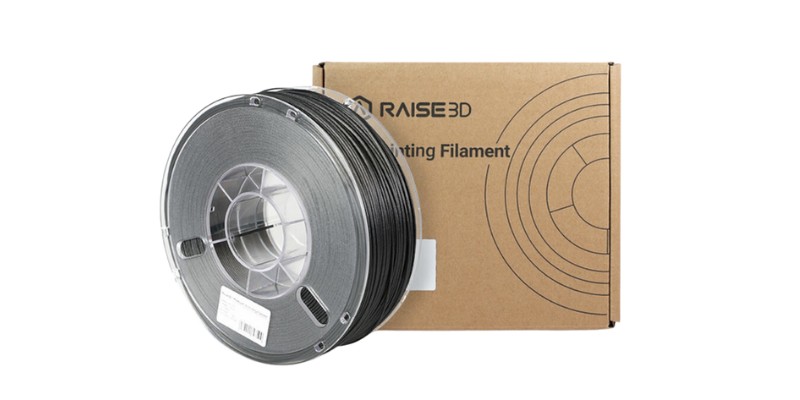
Raise3D PA12 CF consists of industrial-grade Nylon 12 and PA12 carbon fiber for impressive strength, rigidity, and heat resistance. The formula is also designed to minimize warpage and water absorption, common issues that surface when printing with Nylon.
Parts printed with Raise3D PA12 CF can work as lightweight replacements metal parts, with an excellent strength-to-weight ratio suitable for applications in the aerospace and automotive fields.
Despite low warp properties, Raise3D PA12 CF isn’t the easiest to print, requiring a hardened nozzle, tweaking of settings, and proper annealing treatment to get the full filament properties. A high price of around $200 per spool makes it costly, but the extra spend is worth the outstanding results Raise3D PA12 CF is capable of producing.
Why 3D Print with Carbon Fiber Composites?

With the added carbon fiber strands, carbon fiber composite filaments are incredibly strong, yet much cheaper than premium filaments like PEEK, ULTEM, or PC. Carbon fiber has very low shrinkage and excellent dimensional stability, and is very light for its strength.
The base resin used, amount of CF, and size of the individual particles of carbon in the material affect a range of factors, including printability, cost, and finished part strength.
However, you cannot print carbon fiber filaments on a brass nozzle – it is abrasive and will chew through the nozzle. You need to use a hardened steel nozzle, and some use ruby-tipped nozzles instead.
The carbon particles can also clog nozzles, as they don’t melt during printing like the rest of the filament does.
But, the right blend of resin and CF can make a superior, hard, stiff, and durable material that will rival any other filament available for consumer FDM printing. So, for those projects where nothing else will do, carbon fiber is your go-to filament.
Pros
- High strength-to-weight ratio
- Low shrinkage
Cons
- Abrasive and requires a hardened steel or ruby-tipped nozzle
- The small carbon fibers can clog nozzles
- Can make some filaments like ABS and PLA more brittle
“Our printers don’t just print objects, they print ‘oops’, ‘ah-ha’, and ‘not again’ moments.”





0 Comments